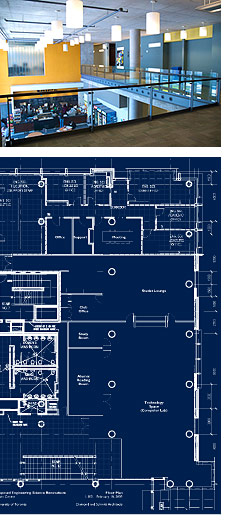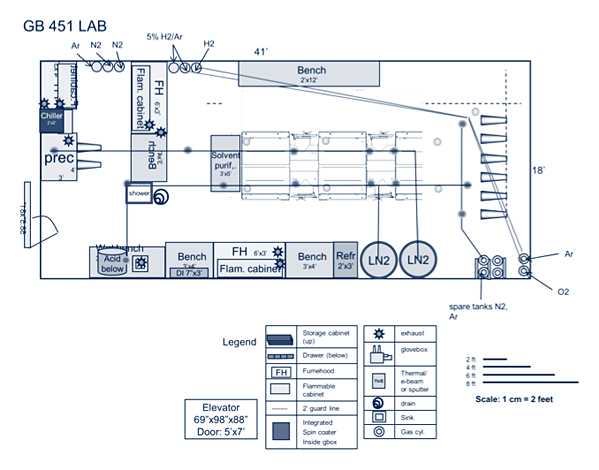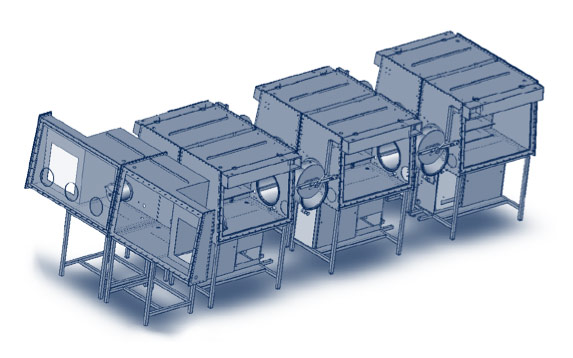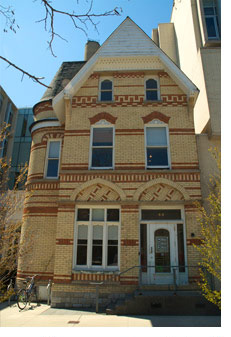 |
|---|
Projects Underway
EngSci Student Space | SF Atrium | ECE Photovoltaics Research Lab | |

BA Engineering Science Student Space
Student Space
As a result of the Faculty’s decision to consolidate the Decanal offices in the Bahen Centre, the space occupied by Engineering Science students has had to be relocated to space previously occupied by the Engineering Computing Facility (BA2124, 2124A, 2124B, 2126, and 2128), with minimal alterations. With the acquisition of tutorial room BA2130 through negotiation with the Office of Space Management and the possibility of capturing previously unassigned space in corridor BA 2130K, an opportunity has been created to renovate and increase the amount of space available to Engineering Science students.
Engineering Science admits approximately 300 students into First Year, which translates into 800-900 students across all four years of the program and makes it the largest undergraduate program in the Faculty. From the outset, the flagship Bahen Centre was designated the home for Engineering Science.
The proposed new location on the second floor of the Bahen Centre will have several benefits for the students in this program: improved access from the main entrance on St. George Street, increased visibility within the building itself, increased space to accommodate growth in student numbers and immediate proximity to the Decanal suite.
Administrative Space
The principal administrative space for Engineering Science is located in the Bahen Centre in suite BA2110, adjacent to the student spaces. There is a long history of the Engineering Science administrative offices being close to the student spaces as a tangible sign of the support the Faculty provides to the students in this demanding program. The administrative offices will continue to be adjacent to the new student spaces, but require some relatively minor redesign to suit the needs and workings of the academic unit that have changed since the office suite was originally designed, including a meeting room and an additional administrative office.
The new meeting room will be large enough to function as a multi-use space to accommodate other needs of the unit such as faculty/staff group work, summer students, staff lunch room, etc. The addition of the new office space will allow the unit to relocate one of the temporary offices currently located in the reception area to a more secure, quieter area.
SF Atrium Floor and Seating Replacement
By: Igor Denisov, Engineering Science - Infrastructure 0T9, Atrium Renovation Committee Chair, University of Toronto
The Atrium Renovation Project has its origin in 2004 when the original Atrium Renovation Committee was put together and the first Atrium Levy was passed.This committee consisted of Jason Chang, Krystin Scheider, Eric Tsoi, and Akash Chokshi. The committee ran a design competition and chose the design from Bortolotto Architect as the winner.The original project included a glass staircase from the ground floor of Sandford Fleming into the pit and environmentally-conscious features such as a green wall fed by rain water, fish tanks further recycling this water, fiber-optic hybrid sunlight and conventional lighting and a virtual sky ceiling display. After the design was priced, the committee set out to work with the Advancement Office to raise the required funds. The student levy was also passed, collecting around $200,000 over two years.
In early 2007, a new committee was put together due to many members of the original group graduating. This new committee consisted of Igor Denisov, Kristen Facciol, Iassen Alexiev, Charlsie Searle, David Lee, and Geoffrey Sui. After extending the levy to 2009, the main task was to evaluate and update the original design according to the new needs of the students. As a result, the project was separated into several phases, each containing an amount of work that could be accomplished over a summer closure of the space.
After a year of having little luck putting together an official fundraising package and fundraising, the committee chair made the decision to go ahead with a more modest Phase I that would leverage the damped market conditions to deliver a design satisfying the students' most pressing needs from the space: better seating, lighting, and general comfort. Thus, Phase I of the renovation, scheduled for completion in August 2009, will include a new floor finish, lighting, and seating.
After some in-house research, solutions and products were found that satisfy the project's aesthetic and functional requirements and yet allow the entire phase to be financed by the student levy. By financing the initial renovation solely with student money, the Atrium Renovation Committee hopes to send a strong message to potential donors and the University itself: this is a project driven by students, financed by students, and one that had students take initiative to satisfy the need for their own space. Once completed, we hope the space will be a unique and updated reflection of the Engineering students' identity and character, a space at once elegant, refined, and yet able to with withstand pranks, construction, and carpentry practice.
ECE Photovoltaics Research Lab
The goal of our solar energy research is to make solar cells that are both high in efficiency and low in cost. To do so, we employ solution-processed semiconductor nanoparticles whose diameter determines which of the sun's broad spectrum of colors the nanoparticles absorb. Our ability to tailor the light-absorbing portion of our solar cells ultimately enables us to make full-spectrum solar cells that make the most of the energy contained in each of the sun's spectral bands.
At the core of our research is a laboratory that will enable reproducible fabrication of high-performance, low-cost solar cells. The laboratory will provide an outstanding degree of control over the processing environment at every stage in fabrication - synthesis, solution-phase materials processing, film fabrication, and contact formation. This laboratory will represent the foundation for the advanced stages of our research.
The laboratory layout is depicted below: 
Among other facilities, the laboratory will house a system that comprises six gloveboxes connected in two rows and ending with a shared glovebox-contained deposition and testing system. The deposition system will contain e-beam, sputtering, and evaporation sources. 
The system will also be enhanced with a solvent purification system, and a precursor-synthesis glovebox-fumehood unit situated in the same laboratory.
The system will enable purely anhydrous, glovebox-contained device fabrication. The steps of nanocrystal isolation, ligand exchange, thin device fabrication, and contact deposition will all be carried out without air exposure. The top-of the line sputtering, evaporation, and e-beam sources will permit creation of high quality contacts from any source materials under controlled environment of Nitrogen, Hydrogen, Argon, and mixtures of these gasses. The ability to run two device fabrication processes in parallel will permit experimentation with a variety of material systems, while minimizing the requirement of full Schlenk lines purification when switching from one material system to the other. Treatment methods, such as thiol washing, can be restricted to one side only, minimizing the risk of undesired interaction on the other side.
The solvent purification system will reduce moisture and oxygen to ppm levels in the commonly used solvents, and allow better control over solvent purity by direct, on-the-fly delivery inside the gloveboxes, which is essential to minimize process cross-contamination that can occur when individual solvent bottles are used. This will also eliminate the need for separate time-consuming purifications processes for heavily used chemicals.
In addition to enhancing considerably the new device fabrication pathways, the new system will significantly increase the efficiency of our research and development. Two teams will work in parallel on both sides of the main system while having access to the synthesis and solvent purification in the same room.
The laboratory will also house a synthesis glovebox and fumehood facilities, additional fumehoods for material processing and a wetbench for equipment cleaning and substrate preparation.
The laboratory will be equipped with custom nitrogen and high-purity gas delivery systems and fast internet available throughout the room.

Administrative functions and services within the Faculty have increased in recent years as a result of recent undergraduate and graduate enrolment growth, administrative changes to programs and promotional activities and research initiatives within the Faculty. The Faculty’s Decanal offices are currently located in several places on the ground floor of the Galbraith Building, in the Mechanical Eng Building, and in the Bahen Building. There is a pressing need to consolidate these offices in a single location to improve efficiency and service.
The least expensive option to achieve this objective is to create a new Decanal Suite within the Bahen Centre on the ground floor and second floor levels of the Old House and areas directly adjacent on both floors. This requires the relocation of the first floor ECE Student Common Room, BA 1000 and second floor EngSci rooms. The relocation of PEY is already underway, as a separate project, to address to accommodate growth in that unit.
Construction began in January 2009, with occupancy scheduled for August 2009.
MIE & MSE Fumehood Stack Extension
MIE and MSE are collaborating on the replacement of the existing fumehood stack serving BA 8208, which was taken out of service approximately two years ago following health and safety concerns. Work is now in progress to reposition and extend the height of the stack to allow the fumehood in BA 8208 to be put back in service for use by MIE and MSE researchers.